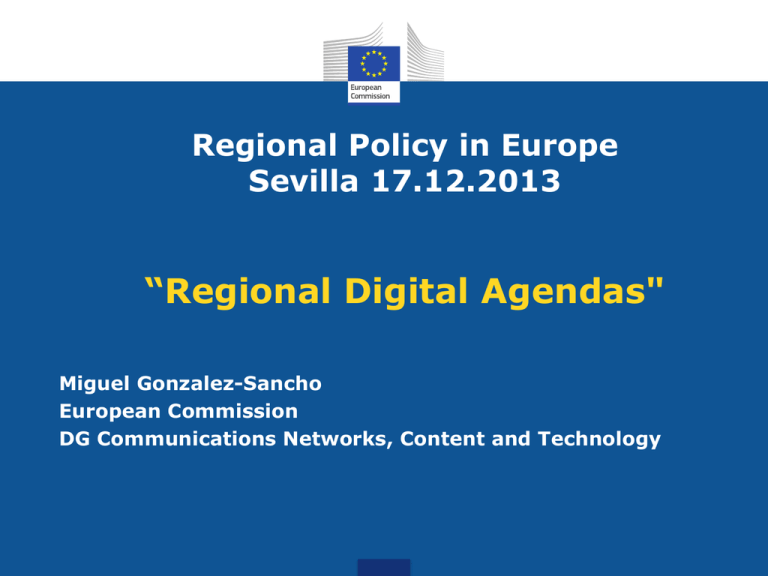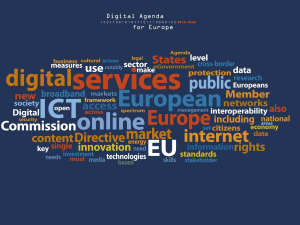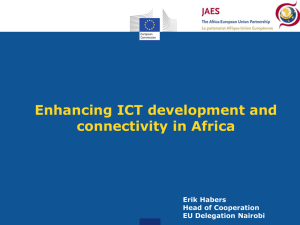Broadband - Agencia de Innovación y Desarrollo de Andalucía IDEA
advertisement

Regional Policy in Europe Sevilla 17.12.2013 “Regional Digital Agendas" Miguel Gonzalez-Sancho European Commission DG Communications Networks, Content and Technology Overview • Digital Agenda and scoreboard • Broadband • Cohesion policy and ICT • Jobs & skills; Horizon 2020; conclusions Political context: EU2020 to DAE Europe 2020: 7 flagships o o o o o o o "Endorsing the cloud" could add 0,1-0,4% of GDP growth to the EU. Digital Agenda for Europe Youth on the move Innovation Union Industrial policy for globalisation era New skills for jobs EU Platform against poverty Digitalized SMEs Resource efficient Europe ICT = 6% of EU GDP Internet usage X2 every 2-3 years, Wireless connected devices: doubling from 25 to 50BL, 2015-20 Mobile data traffic: x12-14, 2012-18 produce 10% more, grow and export twice and create twice the jobs ordinary ones do Internet has contributed to 21% of GDP growth across the G20 from 2005 to 2010 ICT investment →50% productivity growth GROWTH 4 million ICT workers, grow 3% p.a. even in crisis Digital technology matters for Growth & jobs… Digital Agenda logic: networks, services, demand… 100 actions (+ 32 after review), targets A vibrant digital single market Fast & ultra-fast Internet access Using ICT to help society Trust & Security Research & innovation Interoperability & standards (+ cloud computing, after DAE review) Digital literacy, skills & inclusion Digital Agenda governance Going Local 2013 DAE High Level Group Acciones de la Agenda Digital, situación el 17.12.2013 • Total acciones: 101 (DAE 2010) + 30 (revisión 2010) = 131 • Acciones concluidas: 64 (DAE 2010) + 14 (revisión 2010) = 78 • Acciones conformes al calendario previsto: 27 (DAE 2010) + 16 (revisión 2010) = 43 • Acciones atrasadas: 7 (DAE 2010) + 1 (revisión 2010) = 8 Details on each action (update 12.06.2013) available at: https://ec.europa.eu/digital-agenda/sites/digitalagenda/files/130606%20DAE%20actions%20progress%20incl%20review%20FINAL.doc%5B1%5D.pdf DAE – Objetivos clave 1. Objetivos de banda ancha: •Banda ancha de base en 2013 para 100 % de ciudadanos de la UE. •Banda ancha rápida (> 30 Mbps) en 2020 para 100 % de ciudadanos de la UE. •Banda ancha ultra-rápida (> 100 Mbps) en 2020 para 50 % de hogares europeos. 2. Mercado único digital: •En 2015, 50 % de la población debe hacer compras en línea. •En 2015, 20 % de la población debe hacer compras en línea transfronterizas. •En 2015, 33 % de las PME deben hacer compras/ ventas en línea. •En 2015, tarifas de roaming casi igual a tarifas de comunicaciones nacionales 3. Inclusión digital: •Aumento del uso regular de Internet de 60 % a 75 % en 2015 y de 41 % a 60 % para GRUPOS desfavorecidos. •Hasta 2015, reducción del porcentaje de la población que nunca ha usado Internet a la mitad (al 15 %) 4. Servicios públicos: •En 2015: 50 % de los ciudadanos deben recurrir a administración pública en línea e mas de la mitad rellenar y enviar formularios. •En 2015, deben estar disponibles en línea todos los servicios públicos esenciales transfronterizos incluidos en la lista a aprobar por los Estados Miembros para el 2011. 5. Investigación e innovación: •Duplicar la inversión pública, hasta alcanzar 11.000M€. 6. Economía con baja emisión de carbono : •Promocionar la iluminación de bajo consumo: en 2020, reducción global como mínimo del 20 % del consumo de energía en alumbrado. Scoreboard 2013 To find out more visit www.ec.europa.eu/digital-agenda/en/scoreboard https://ec.europa.eu/digital-agenda/en/scoreboard/portugal 8 Basic broadband for all by 2013 Standard fixed broadband* availability adding wireless, EU coverage is 99.97% *xDSL, Cable, FTTP and WiMax; Source: Point Topic 9 At least 30 Mbps for all by 2020 NGA* availability (54% of EU homes) But only 12% of EU rural areas are covered * Next Generation Access (NGA): VDSL, Cable Docsis 3.0 and FTTP; Source: Point Topic 10 Fixed broadband take-up Fixed broadband lines penetration in the EU 28.8% (lines as a % of population) (equivalent to 72.5% of EU homes subscribing to broadband) Source: Communications Committee 11 Fixed broadband lines by speed 14.8% of EU fixed broadband subscriptions are at least 30 Mbps and 3.4 % at least 100 Mbps Source: Communications Committee 12 2% of Europeans have never used the Internet, 70% are regular Internet users (at least once a week) (2012) Source: Eurostat 13 Citizens engaging in eCommerce (domestic & cross border) (% of all citizens, 2012) Source: Eurostat 14 eCommerce: SMEs selling online (% of all SMEs, 2012) 60% eCommerce: SMEs 50% 40% 30% 20% 10% 0% BG IT RO LV EL CY PL HU AT FR EE SK ES selling online SI EU27 LU MT PT LT FI UK NL DE BE IE CZ DK SE buying online Source: Eurostat 15 eGovernment •Electronic interaction by citizens* with public authorities (2012) 100% 90% 80% 70% 60% 50% 40% 30% 20% 10% 0% Source: Eurostat *Citizens aged between 25 and 54 Source: Eurostat 16 eGovernment Take-up of eGovernment by SMEs While most large enterprises already use eGovernment services the take-up by SMEs is slow 100% 90% 80% 70% 60% 50% 40% 30% 20% 10% 0% Source: Eurostat 17 Levels of computer skills (2012) 40% 35.4% 35% 30% 25.3% 25.6% 25% 21.3% ES 20% EU27 15.7% 15% 10.8% 10% 5% 0% Low skills Medium skills High skills Source: Eurostat Moreover: in 2011, only 53% of European labour force judged their computer or Internet skills to be sufficient if they were to look for a job or change job within a year (Eurostat). 18 Difficulties in recruiting ICT professionals 3% of EU Enterprises that recruited ICT specialists, had difficulties in filling IT vacancies Enterprises that recruited ICT specialists, with and without difficulties in filling vacancies, 2012 (% of enterprises) 16 14 12 10 8 6 4 2 RO IT CZ HR NO SK SI NL FR ES IE EA SE PT PL AT MT HU LV EE EU27 LT BE MK UK FI LU CY EL DK BG DE IS 0 recruited/tried to recruit and had no hard to fill vacancies recruited/tried to recruit and had hard to fill vacancies Source: Eurostat 19 Overview • Digital Agenda and scoreboard • Broadband • Cohesion policy and ICT • Jobs & skills; Horizon 2020; conclusions Broadband drives competiveness Correlation Fixed Broadband Penetration and Competitiveness WEF's Global Competitive Index score 5.8 Sweden 5.6 Finland Japan 5.4 5.2 US UK Belgium Austria Germany 4.8 Netherlands France Luxembourg 5 Denmark Korea Ireland Estonia 4.6 Czech Rep. Poland 4.4 Portugal Lithuania Italy Hungary 4.2 Bulgaria Slovakia Spain Cyprus Slovenia Malta Latvia Romania 4 0.1 0.15 0.2 0.25 0.3 0.35 0.4 0.45 Fixed broadband lines per 100 population "An increase in the broadband penetration rate by 10 percentage points raises annual growth in per-capita GDP by 0.9 to 1.5 percentage points" (Czernich et al. - CESIFO WORKING PAPER NO. 2861, Ifo Institute for Economic Research, 2009) Map of NGA broadband coverage (2012) EU broadband policy – key areas Market framework Financing and funding • Cost reduction initiative • • eComms regulation, e. g. Recommendation on non-discrimination and costing methodologies European Structural and Investment Funds (ESIF) • Connecting Europe Facility (CEF) • Broadband state aid guidelines • Demand Stimulation • Single EU authorisation • European inputs: Spectrum and access products • Single consumer space: Net neutrality, harmonised end user rights, roaming Single market for eComms 23 Cost reduction measures Regulation on measures to reduce the cost of deploying highspeed electronic communications networks Increased use of passive infrastructures suitable for high speed internet network rollout Increased cooperation in civil engineering works Streamlined permit granting procedures Increased number of buildings ready for high speed internet access Investment costs are expected to be reduced by 20% to 30% potential savings up to 60 bn EUR across the EU • Proposal adopted by the College on 26 March 2013 • Adoption envisaged by Q2 of 2014 24 Connected continent proposal Single EU authorisation User rights Wireless broadband: spectrum Net neutrality Fixed broadband: virtual access products Roaming EU financing EU financing for broadband • European Structural and Investment Funds (ERDF and EARDF): grants and financial instruments • Connecting Europe Facility (CEF): Some complementary EU support by means of financial instruments • Currently project bonds pilot – open for project proposals • Possibly greater EIB lending activity in ICT/broadband following capital increase 26 Overview • Digital Agenda and scoreboard • Broadband • Cohesion policy and ICT • Jobs & skills; Horizon 2020; conclusions ICT and the Information society - A vision of Convergence ICT : not just a "sector" (telecom) > enabler for all socio-economic sectors Broadband : from "nice-to-have" to "must-have" > pre-condition for growth and productivity ICT : no longer "hardware v.s. software" > cloud computing, mobility and ubiquity Convergence of ever faster networks with ever smarter devices and ever richer contents 28 Basics on current Cohesion Policy Funds allocated to ICTs in 2007-13: • • over EUR 15 billion or 4.4% of the total cohesion policy budget. Shift in the investment priorities from infrastructure to support for content development, both in the public sector (eHealth, eGovernment, etc.) and for SMEs (eLearning, eBusiness, etc.) Cohesion Policy Absorption rate as of 2012 72.9% 86.9% 47.5% 90.6% 42.9% 71.3% 78.4% Services and Services and applications for Telephone applications for Information and Information and SMEs (eOther measures for infrastructures citizens (ecommunication communication commerce, improving access (including health, etechnologies technologies education and to and efficient use broadband government, e(...) (TEN-ICT) training, of ICT by SMEs networks) learning, enetworking, inclusion, etc.) etc.) 10 11 12 13 14 ICT Average 15 30 sustainable inclusive Europe 2020 smart Thematic objectives 1. Research and innovation 2. Information and Communication Technologies 3. Competitiveness of Small and Medium-Sized Enterprises (SME) 4. Shift to a low-carbon economy 5. Climate change adaptation and risk management and prevention 6. Environmental protection and resource efficiency 7. Sustainable transport and disposal of congestion on major network infrastructure 8. Employment and support for labour mobility 9. Social inclusion and poverty reduction 10. Education, skills and lifelong learning 11. Increased institutional capacity and effectiveness of public administration Thematic concentration in Cohesion Policy SME competitiveness Energy Smart Grids Innovation Human Capital Skills Mobility R&I infrastructures Public sector Innovation +admin. capacity ICT Broadband Thematic concentration of the ERDF Research and Innovation SMEs competitiveness 60% Energy efficiency and renewable energy + ICT access, quality and use 20% Developed regions and transition Transition regions: 60regions % Concentration on "two or more of the thematic objectives 1, 2, 3 and 4" 6% 44% Less developed regions concentration (incl. 15% for(different regions present different needs) Flexibility energy/renewables) Special arrangements for the previously convergence regions Calendar for partnership agreements & OPs Partnership Agreement Country / region specific Operational programmes General regulation adopted European Territorial Cooperation ("INTERREG") programmes Max 4 months Partnership Agreement Submitted (MS) Max 3 months Max 3 months Observations by EC All OPs incl. Ex-ante eval. (except ETC) (MS) Max 9 months Max 1 month Partnership Agreement Adoption Max 3 months ETC OPs (MS) Observations by EC Max 3 months Max 3 months OP Adoption (EC) Observations by EC Max 3 months ETC OP Adoption (EC) 34 Ex-ante conditionalities Thematic Objectives N°1 Research and innovation N°2 - ICT use and quality - ICT access All other Thematic Objectives Ex-ante conditionality "Digital Growth" Strategic policy framework: - R&I Smart Specialisation Strategy (RIS3) and/or - National/Regional Digital Agenda Next Generation Network (NGN) Plan Corresponding exante conditionalities Cohesion Policy Vision of CONVERGENCE Thematic Objective 2: Enhancing access to + use and quality of, information and communication technologies Investment priorities under TO 2: a) diffusion of broadband and high speed networks, supporting adoption of emerging technologies and networks for the digital economy b) development of ICT products and services, electronic commerce and increased demand for ICT c) strengthening the application of ICT for eGovernment, eLearning, eInclusion and eHealth Ex ante conditionalities: Next Generation Access Plan Strategic policy framework for digital growth (also in RIS3) Criteria for assessing the Digital Growth Strategies A Plan based on Economic Analysis • Explicit methodology and data sources including involved stakeholders • Existing & planned infrastructures - Map on two dimensions : coverage/access and take-up/subscription - Market failures in the socio-economic context (topography, pop. density, demand factors – e.g. affordability, education, etc.) Criteria for assessing the Digital Growth Strategies A SWOT analysis (or similar) consistent with Digital Agenda Digital Agenda Toolbox • http://s3platform.jrc.ec.europa.eu/digital-agenda Digital Agenda Scoreboard Indicators • http://ec.europa.eu/digital-agenda/en/create-graphs • http://digital-agendadata.eu/datasets/digital_agenda_scoreboard_key_indicators/indicators Ex-ante conditionalities Ex-ante conditionality N°2(2) for ICT infrastructure Ex ante conditionality 2.2. Next Generation Network (NGN) Infrastructure: The existence of national and/or regional NGN Plans which take account of regional actions in order to reach the Union high-speed Internet access targets and promote territorial cohesion, focusing on areas where the market fails to provide an open infrastructure at an affordable cost and of a quality in line with the EU competition and State aid rules, and to provide accessible services to vulnerable groups. Criteria for fulfilment A national or regional NGN Plan is in place that contains: – a plan of infrastructure investments based on an economic analysis taking account of existing private and public infrastructures and planned investments; – sustainable investment models that enhance competition and provide access to open, affordable, quality and future proof infrastructure and services; – measures to stimulate private investment. Criteria for assessing the NGN Plans A Plan that is operational Target & Indicators – benchmarking with the Digital Agenda Scoreboard • • http://ec.europa.eu/digital-agenda/en/create-graphs http://digital-agenda-data.eu/datasets/digital_agenda_scoreboard_key_indicators/indicators Available budgetary resources • Public funding at EU, national, regional levels • Other sources : private, banks List of planned investments • Objectives, estimated cost, coverage • Periodically up-dated Criteria for assessing the NGN Plans A Plan of sustainable models • Envisaged investment models - Broadband investment Guide - Use of grants, financial instruments ? • Regulatory measures to stimulate private investment - Cost-reduction measures - Radio spectrum Criteria for assessing the NGN Plans Identifying the priorities & capacity Priorities and budgetisation • available budgetary resources for ICT interventions • sources of finance at EU, national and other sources Administrative Capacity • Self analysis: intermediate bodies and beneficiaries • Remedial actions Overview • Digital Agenda and scoreboard • Broadband • Cohesion policy and ICT • Jobs & skills; Horizon 2020; conclusions Grand Coalition 5 Policy Clusters ICT TRAINING: Online ICT learning platforms Smart grid training, etc. NEW LEARNING: Industry/education provider collabor. MOOC for secondary teachers CERTIFICATION: Support roll-out of common eCompetences framework MOBILITY: Launch mobility assistance services AWARENESS RAISING: GetOnline Week Europe 2020 priorities Shared objectives and principles ICT ICT ICT ICT ICT ICT Tackling Societal Challenges Health, demographic change and wellbeing Food security, sustainable agriculture and the bio-based economy Secure, clean and efficient energy Smart, green and integrated transport Climate action, resource efficiency and raw materials Inclusive, innovative and reflective societies Secure Societies EIT JRC Simplified access Creating Industrial Leadership and Competitive Frameworks Leadership in enabling and industrial technologies ICT Nanotech., Materials, Manuf. and Processing Biotechnology Space Access to risk finance Innovation in SMEs Excellence in the Science Base Frontier research (ERC) Future and Emerging Technologies (FET) Skills and career development (Marie Curie) Research infrastructures ICT ICT ICT Common rules, toolkit of funding schemes Dissemination & knowledge tranfer European Council of 24-25.10.2013; digital economy and innovation • Complete Digital Single Market • Access to and portability of content and data across the single market • EC legal proposals on telecoms: connected continent; broadband engineering costs • EC legal proposals on trust and security: e-ID; network information security; einvoicing/ payments; data protection; web accessibility • Data, cloud, open government • Taxation of the digital economy • Skills • Research and innovation Conclusions • Digitally-driven transformation is unstoppable; Europe cannot stay behind • Need for public sector strategies; European/ national/ local digital agendas • Remove barriers in the European space; towards a Digital Single Market • Build European capacity: networks, data/ cloud, skills, R&D&I, industrial base… • New EU legislature will start in 2014; in any case, the future is digital… Gracias ec.europa.eu/digital-agenda blogs.ec.europa.eu/digital-agenda @DigitalAgendaEU DigitalAgenda






